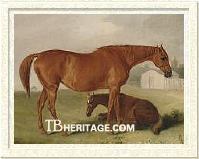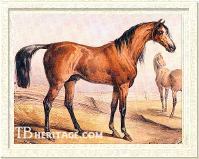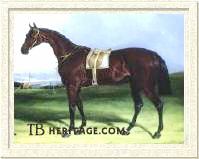|
|
Cobweb

|
|
 |
|
|
Cobweb, called the "Queen of racing mares," was an unbeaten classic winner whose conformation and elegance prompted many turf observers to wax poetic regarding her beauty and quality. She produced three classic winners, two influential sire sons and a daughter that sent her tail-female line forward, replete with stakes winners and significant broodmares whose descendants are still among the best of the breed today.
Cobweb's family had been nurtured in the stud of George Child-Villiers, the fifth Earl of Jersey, at Middleton Park, Middleton Stoney in Oxfordshire, beginning with Web (1808, by Waxy), the sister of those two pillars of the studbook, Whisker and Whalebone. Web had been purchased from the Duke of Grafton. She was a daughter of the great Grafton foundation mare, Penelope.
As foundation mare of the Jersey stud, Web produced Derby winner Middleton for Jersey, and two daughters that had a profound influence on the breed, seen in Family 1-s, Web's branch of Family 1. Her daughter Trampoline (1825), by the great four-miler Tramp, won a race for three year old fillies at Newmarket and ran second in the One Thousand Guineas: retired to Jersey's stud she produced Glencoe (1831, by Sultan), winner of the Two Thousand Guineas and very influential at stud, particularly as a broodmare sire. Glencoe got one of the most influential mares in thoroughbred history, Pocahontas, while in England, and after his purchase to America, became a leading sire eight times in the 1840s and '50s. His offspring there included the great race mare Peytona, the stellar American broodmare Reel, and the influential sire Vandal, among many other 19th century American greats. Glencoe's sister, Glencairne had many successful tail-female descendants (Family 1 -t).
|

Cobweb's dam, Filagree with Charlotte West at foot |
|
Web's daughter Filagree (1815, sometimes "Fillagree") was by St. Leger winner and leading sire (1819) Soothsayer, by the excellent black stallion Sorcerer. She won her only race at Newmarket at age three in 1818. Filagree produced twenty foals for the earl, beginning in 1819, and ending in 1841. In addition to Cobweb, her third foal, her offspring included One Thousand Guineas winner Charlotte West (1827, by Tramp), Two Thousand Guineas winner Riddlesworth (1828, by Emilius), the good runners Ilderim and Muley Ishmael, and several daughters that were dams or second dams of classic winners and whose tail-female lines descend to the present. Such important mares as Queen Bertha and La Troienne descend from Filagree.
|
Cobweb's sire, Phantom, was the son of the multiple royal plate winner and stayer Walton. Bred and raced by Sir Hedworth Williamson, Walton was sold at the end of his career on the turf to Sir John Shelley of Sussex, who was a good friend and hunting companion of Jersey's, and had introduced him to the joys of the turf around 1804-05. The two men had a loose partnership in race horses, and Phantom, bred by Shelley and later a stallion at his stud in Sussex, was well-used by Jersey in developing his stud. Phantom won seven races at age three, including the Derby, and four races at age four. He led the sire's list in 1824 due to Cobweb's successes and those of his Derby-winning son Cedric (1821, bred and raced by Shelley). A year later, 1825, his son Middleton, out of Web, bred, raced and owned by Jersey, won the Derby, and later Middleton's brother, Glenarty, won the Riddlesworth Stakes for the earl. Phantom also got Two Thousand Guineas winner Enamel.
Cobweb's fine points were rhapsodically described in the Sporting Magazine: "The elegance of her outline, her splendid symmetry, and legs so finely and beautifully formed, and black as ebony itself, combined to render the materials and proportions of which she was composed altogether matchless."
Chart: Web/Cobweb's Female Family
Cobweb on the Turf
Cobweb had a brief and brilliant career on the turf, running only one season in Jersey's black colors under the supervision of his trainer, James Edwards, known for his perfect timing in getting his horses fit for winning races and who schooled Jersey's nine classic winners. Like all of Web's family, of which Edwards once said "They're fat as pigs," she always, said The Druid, "ran in the flesh." The latter described her as "one of the finest and most perfect mares that ever looked through a bridle."
She first ran in a sweep for three-year-old fillies at Newmarket Craven, easily winning by two lengths. Her next race was at Newmarket First Spring, where she received forfeits of £100 from the other two subscribers. Her next race, with the great jockey Jem Robinson aboard, was the One Thousand Guineas, when she became Jersey's first classic winner by beating Rebecca (by Soothsayer), Milto (Muley), and Spree (Frolic).
Her last race was the Oaks, for which "she did no work for nearly ten days before...with the exception of a few half-speed gallops." With Robinson in the saddle, she came in 1-1/2 lengths ahead of the fourteen-filly field, which included Fille-de-Joie (Filho-da-Puta), Rebecca, Tiara (Castrel), Miss Jigg (Partisan), and others that later made names for themselves as broodmares. After this race, "..as sound and well as it was possible for a horse to be," she was retired to the Jersey stud.
Cobweb in the Stud
Cobweb's production record matched, or exceeded, her excellence on the turf. She produced a succession of good horses for Jersey, starting in 1827, and ending in 1844, missing only three times in those years, in 1838, '41, and '43; after that she missed three years in succession, and died in 1848. While she herself had feet which "were very fine and sound," her grandsire, Soothsayer, said The Druid, "...had a club foot which compelled him to do a good deal of his work on the straw. This defect, which slumbered for two generations, brought unsoundess into her stock (of which Achmet was perhaps the handsomest); and a slight contraction of one of the front feet is observable in many of the descendants of Bay Milddleton." Nonetheless, she produced six high-class stakes winners, of which three were classic winners, two highly influential sire sons, and a daughter that sent her tail-female family line on to glory. These good offspring were by four different sires, a sure sign of a superior broodmare. None of Jersey's famous horses ran at age two, because he was highly prejudiced against running youngsters, so none of Cobweb's offspring, with the exception of Clementina, who was sold as a yearling (and did very well as a juvenile), ever got a crack at the big juvenile races.
|
| PRODUCE RECORD OF COBWEB |
| Year | Name | Stats | Sire | Notes |
| 1827 | Unnamed | ch.f. | Comus | -- |
| 1828 | Young Emilius | b.c. | Emilius | Sold to France, sire of champions and classic producers |
| 1829 | Unnamed | br.c. | Master Henry | -- |
| 1830 | Lucius | ch.c. | Emilius | Won Riddlesworth Stakes |
| 1831 | Nell Gwynne | ch.f. | Sultan | Pacemaker in Oaks |
| 1832 | Mahomet | b.c. | Sultan | Winner |
| 1833 | Bay Middleton | b.c. | Sultan | Won Riddlesworth Stakes, 2,000 Gs, Derby, Grand Duke Michael St. and other races |
| 1834 | Achmet | b.c. | Sultan | Won Riddlesworth Stakes, 2,000 Gs, other races |
| 1835 | Phoenix | b.c. | Buzzard | Won Riddlesworth Stakes |
| 1836 | Caesar | b.c. | Sultan | Won Riddlesworth Stakes, 3rd 2,000 Gs |
| 1837 | Glenorchy | ch.c. | Glencoe | Sent to India |
| 1838 | Missed To Sultan |
| 1839 | Jersey | b.c. | Buzzard | Sent to Australia, broodmare sire of classic winners there |
| 1840 | Catesby | b.c. | Slane | -- |
| 1841 | Missed To Slane |
| 1842 | King Cob | b.c. | Slane | Sold to Prince of Orange |
| 1843 | Missed To The Saddler |
| 1844 | Clementina | b.f. | Venison | Won Bretsby St., Prendergast St., Nassau St., 1,000 Gs and 2nd Oaks |
| 1845 missed to Venison, 1846 missed to Cotherstone, 1847 missed to Ion, 1848 covered by The Knight of the Whistle but died |
| Of her offspring, one of the most notable was YOUNG EMILIUS (1828, by Emilius), purchased to France by the Societe d'Encouragement, where he was a successful sire, getting the champion French runner Fitz-Emilius, Prix du Jockey Club winner Amalfi, and many other good runners. His brother, LUCIUS (1830), won the Riddlesworth Stakes, the first of five of Cobweb's offspring to do so. This race was at the time an early Newmarket prep race for the classics, one of the most important stakes for three-year-olds, worth £1,000 more than the Two Thousand Guineas, and Jersey had a virtual lock on it for successive years in the 1830s.
|

Young Emilius

Bay Middleton
|
|
Next came the chestnut filly NELL GWYNNE (1831), by the six-time leading sire Sultan. She was a fast filly, who set the pace in the Oaks of her year, but failed to place in it. There is no record of any produce from her in the GSB. After that was her brother, MAHOMET (1832), who was a modest winner. Then came their full sibling BAY MIDDLETON (1833), the undefeated dual-classic winner who was later twice leading sire in England, and sire of the great horse and influential sire, The Flying Dutchman.
Cobweb's next foal was ACHMET (1834, also by Sultan), a handsome bay colt with poor feet. He came to Newmarket uncharacteristically, for Edwards, unprepared, and barely won the Riddlesworth Stakes by a head. His next race was a 200 sovereign sweepstakes at Newmarket, which he won easily, and then he went on to win the Two Thousand Guineas, becoming Cobweb's second classic winner. He was the early favorite for the Derby, but was too lame to run in the classic, which was won by Phosphorus.
Cobweb then produced the bay PHOENIX (1835), by the Blacklock son, Buzzard. He was another winner of the Riddlesworth Stakes for Jersey, but came out of it lame, having "touched upon an old sore." He was babied along by Jersey's new trainer, Edwards having died the year before, skipping the Two Thousand Guineas, with an eye towards the Derby, and many held on to the notion that he was another "best horse to look through a bridle," based on his Riddlesworth win. But he was never in the running in the classic, which was won by Amato, the latter a suprise winner that did nothing of merit before or after that race. |
Phoenix was later a modest sire, mostly of hunters in Cumberland, with two unnamed daughters that had some influence in thoroughbred bloodlines, one, born in 1842 (Family 2 - b), was the tail-female ancestress of winners in New Zealand, Australia and tahe U.S., and the other was the dam of Alix, a good winner in Hungary.
The next year Cobweb dropped another foal to the cover of Sultan, the bay CAESAR (1836). This colt also won the Riddlesworth Stakes for Jersey, which set up the belief that he was another Bay Middleton, despite the fact that his win was over a poor field of "miserable creatures." He was sent on to the Two Thousand Guineas, highly favored to win, but could only run third to The Corsair and Aether. Despite this questionable showing, he was third favorite in the Derby, in a field of 21, but was part of the pack that trailed Bloomsbury, the filly Deception, and Euclid, who placed 1-2-3. The next year Caesar broke down badly in the running of the Claret Stakes, won by Euclid, and was retired to stud. He did little of note in the stud; a son, Linkboy, got some "good chargers and harness horses."
GLENORCHY (1837) was Cobweb's only foal by Jersey's Two Thousand Guineas winner Glencoe, and was a member of Glencoe's sole crop in England. Because Glencoe was a grandson of Web's, Glenorchy was in-bred to her 3 x 3, but this did not help him much. He ran unsuccessfully in the Riddlesworth, and was later sold to the East India Company.
After a barren year, in which she failed to catch to Sultan, Cobweb was returned to Buzzard and produced the bay colt JERSEY (1839). Jersey was sent to Australia, where he was a moderately successful sire, and broodmare sire of some good stakes winners. Cobweb was then bred in three successive years to Colonel (later Major-General) Jonathan Peel's good staying stakes winner Slane; a few years later Peel would breed the speedy runner and leading sire Orlando. To the cover of Slane Cobweb produced CATESBY (1840) and KING COB (1842); King Cob was shipped off to the Prince of Orange's stud at Terverin, several miles from Brussels.
After a year off, failing to settle to the cover of The Saddler, Cobweb was bred to the stayer Venison, an unproven sire at the time. The result was CLEMENTINA (1844), Cobweb's third classic winner, and Venison's second (he also got Two Thousand Guineas winner The Ugly Buck -- his classic win was the year Clementina was born -- and Oaks winner Miami, plus the top stayers Kingston and Alarm). Jersey, whose interest in his racing stable was waning as he aged and as years passed without a return to the successes of his stable when Edwards was alive, sold Clementina, when a yearling, to George Payne. Payne, another turf enthusiast and intimate of the "dictator of the turf," Admiral Rous, had run through several fortunes in his youth before settling down to a more cautious lifestyle. Running for Payne, Clementina was a good juvenile, and good at age three. She won the Bretsby, Prendergast, and Nassau Stakes, and the One Thousand Guineas, and was second to Van Tromp in Goodwood's Lavant Stakes for juveniles, and to Coningsby by a head, carrying seven extra pounds, in Newmarket's Criterion Stakes for two-year-olds. She also ran second by a length to Miami in the Oaks, in a field of very good fillies.
It was through Clementina's daughter, Lady Blanche (1856, by Stockwell), that Cobweb's tail-female family extends prominently into the present. The Grand Prix de Paris and English Two Thousand Guineas winner Paradox (1882, by Sterling); the significant broodmare La Troienne (1926, by Teddy); the dual-classic winning filly and good broodmare Jest (1910, by Sundridge) and her half-brother St. Leger winner Black Jester (1911, by Polymelus); dual classic winner Royal Palace (1964, by Ballymoss), and many other stakes winners descend from Cobweb in tail-female.
--Patricia Erigero
|
|
|
|

